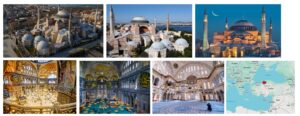A few weeks ago, I wrote about Sainte Chapelle, a compact, tiny-house-of-a-church hidden in the heart of Paris. What struck me while visiting it was its intimate approach to worship. At Sainte Chapelle, you can imagine your god sitting right next to you, sipping a cup of tea, bathed in warm, tinted light streaming down from finely-crafted, precisely-designed, stained-glass windows. This is less of an exalted cathedral experience and more of a family communion.
Compare that with the cavernous halls and soaring roofs of Hagia Sophia in Istanbul, Turkey. Two halls of worship – worlds apart.

Officially titled “The Hagia Sophia Grand Mosque,” H-S is a Muslim mosque, museum and former church. Completed in AD 537, it was the world’s largest interior space for hundreds of years and among the first to employ a “pendentive” dome. (Pendentive is a constructional device allowing the placing of a circular dome over a square room, or an elliptical dome over a rectangular room.)
Considered the epitome of Byzantine architecture at the time of construction, Hagia Sophia was THE Christian cathedral of Constantinople for nearly a thousand years. After the fall of the Ottoman empire in 1453, however, the structure was converted to a mosque by Mehmed the Conqueror and became the principal mosque of Istanbul for 150 years. Complete with Arabic design elements and soaring minarets, it remained a major mosque until 1931, when it was closed for 4 years and then re-opened as a museum. Interestingly, in 2020 the Turkish government reclassified it as a mosque, perhaps showing that you can’t keep a good religious monument down.
Visiting Hagia Sophia is truly an awesome experience, and I mean that very precisely. To look up at the vast, cavernous spaces, the ornate decorations, the massive rounded domes is to feel “awe” in its purest sense. Awe can be defined as a “reverential respect mixed with fear or wonder.” I imagine that was the idea in mind when creating this monumental structure. You don’t come to Hagia Sophia for an intimate chat with your creator. Hagia Sophia is designed to impress, to lift you up, to remind you of the massive scope of divinity.
It’s the kind of place that reminds you that there is something out there much bigger than yourself…something large, powerful and perhaps a little bit scary. Don’t mess with the God of Hagia Sophia if you know what’s good for you!
(Which do you prefer, large impressive spaces or small, intimate venues? Similarly, what’s your approach to life? In Hermann Hesse’s great novel, Narcissus and Goldmund, he writes about two medieval men whose characters are diametrically opposite: Narcissus, an ascetic monk firm in his religious commitment, and Goldmund, a romantic youth hungry for knowledge and worldly experience. One might say that Narcissus prefers a “small” life while Goldmund is itching for something “larger.” Inevitably, after years of sensual living, Goldmund discovers a great artistic talent within himself – one that will require years of sedentary practice to develop. Would his talent have arisen if he had stayed in a small place like monastery a monastery his whole life? Can his talent blossom if he continues to roam and wander, rather than settling down to hone his craft? These are the fantastic themes of this must-read book.
So what are you? A small lifer or a big lifer? Is either one better than the other?)
(Dave Blum is the creator of Dr. Clue Treasure Hunts, www.drclue.com, a teambuilding company featuring over 150 treasure hunt locations worldwide. He has visited over 40 countries in his 60+ years of life and plans to keep traveling until he gives up the ghost. Dave lives in Northern California with his wife, Donica, and their 18-year-old Maine Coon, Ava — an indoor cat who dreams of one day escaping captivity and exploring her own neighborhood Wow Places.)
